This day in history 13 October
Images

Durham: Gresley V3 no 67636 climbs south away from Durham Viaduct on its way to West Auckland with the first leg of the Durham Railtour on 13 October 1962.

West Auckland Colliery: B16 4-6-0 no 61418 is about to get underway with the Durham Rail Tour in the yard at West Auckland Colliery on 13 October 1962, having taken over from V3 no 67636. The train is about to run over West Auckland level crossing and commmence the next leg of the tour which will take the train to Port Clarence.
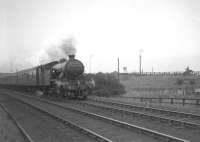
Pelaw: V3 67636 with empty stock from Heaton CS for the Durham Rail Tour of 13 October 1962. After crossing the King Edward Bridge and run east to reach Pelaw the train has turned south under the A184 road on the 'old main line'. This will take it through Washington and Leamside to reach Durham, the starting point for the railtour.

Billingham Beck : The Durham Rail Tour of 13 October 1962 running between Billingham Beck Junction and North Shore Junction on industrial Teesside. B16 4-6-0 no 61418 is taking the train to Stockton following a visit to Port Clarence.
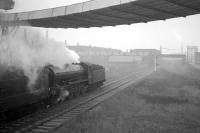
Haverton Hill South Junction [1st]: Having passed through the closed station of Haverton Hill, no 61418 is approaching Haverton Hill South Junction (the original version) with the Durham Rail Tour of 13 October 1962. The train is on the return leg from Port Clarence and at this point is passing through a landscape dominated by various structures linked to the giant ICI Billingham complex. The train will continue to North Shore Junction (a link closed in 1974) in order to reach Stockton station.

Low Fell: B16 no 61418 heads south through Low Fell towards Ouston Junction with the Blaydon - Consett leg of the Durham Rail Tour of 13 October 1962.
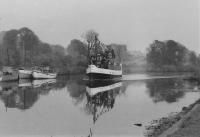
Bowling Upper Basin: MV 'Ashton' on the Forth & Clyde canal in October 1962 with a special charter organised by the Glasgow University Railway Society. In this photograph, the ferry is approaching the upper basin at the western end of the canal at Bowling.
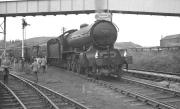
West Auckland Colliery: Scene in the sidings at West Auckland Colliery on 13 October 1962, with B16 4-6-0 no 61418 having taken over the SLS/MLS/Kings College 'Durham Rail Tour'. The special had arrived from Durham behind V3 no 67636 and the B16 was preparing to take charge for the next leg to Port Clarence.

Low Fell: An unidentified class K1 2-6-0 with an up train of mineral wagons passing Low Fell, Gateshead, on 13 October 1962.
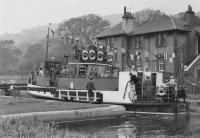
Bowling Upper Basin: The Cumbrae ferry 'Ashton' entering the upper lock at Bowling, with a special charter organised by the Glasgow University Railway Society. I believe the sailing covered the section of the Forth & Clyde canal west of Kirkintilloch and, as far as I know, it was the last occasion on which a passenger vessel sailed on the canal before its closure at the end of 1962. The canal of course eventually reopened in 2001.
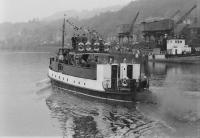
Bowling Harbour: Having completed a special sailing along the western part of the Forth & Clyde canal, the Cumbrae ferry 'Ashton' heads out of the sea lock and into Bowling Harbour on the River Clyde. The charter was organised by the Glasgow University Railway Society in October 1962.

Haverton Hill Junction: 61418 brings the Durham Rail Tour round the east to south curve from Haverton Hill station on 13 October 1962 on its way back from Port Clarence to Stockton. The building in the left background is the former Haverton Hill locomotive shed, closed in June 1959 following the transfer of its stock to the new super-shed at Thornaby see image [[34864]].

West Auckland: 67636 at West Auckland on 13 October 1962, some 4 months after the station had lost its passenger service. The V3 had worked into nearby West Auckland Colliery on the first stage of the Durham Railtour which it had handed over to B16 no 61418.
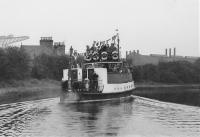
Dalmuir Swing Bridge: The Cumbrae ferry 'Ashton' on the Forth & Clyde canal at Dalmuir, in October 1962. This remarkable charter was organised by the Glasgow University Railway Society. I believe it was the last occasion on which a passenger vessel sailed on the canal before its closure at the end of 1962, although the canal of course eventually reopened in 2001.
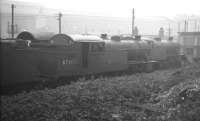
Heaton: V1 2-6-2T no 67602 in the shed yard at Heaton on a misty 13 October 1962. Withdrawn from Eastfield 5 months earlier the locomotive is thought to be on its way south to Darlington Works, where it was cut up in December that year.
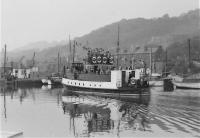
Bowling Canal Basin: MV 'Ashton' between locks at Bowling, on a special Forth & Clyde canal charter organised by the Glasgow University Railway Society. I believe the sailing covered the section of the canal west of Kirkintilloch and, as far as I know, it was the last occasion on which a passenger vessel sailed on the canal before its closure at the end of 1962. The canal of course eventually reopened in 2001.
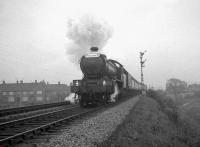
Norton South Junction: B16 no 61418 with the Durham Rail Tour passing Norton South distant signal on the straight section from North Shore Junction approaching Norton South Junction soon after leaving Stockton station on 13 October 1962. The signal box in the background is Stockton Bank, which controlled traffic using Stockton yard. The B16 had taken over the train from V3 no 67636 at West Auckland Colliery earlier that day see image [[25127]].

West Auckland Colliery: B16 4-6-0 no 61418 with the SLS/MLS/Kings College 'Durham Rail Tour' leaving West Auckland Colliery on 13 October 1962 on its way to Port Clarence.
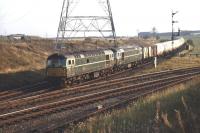
Niddrie North Junction: Class 26 locomotives D5306 + D5300 approaching Niddrie North Junction from the Millerhill direction on 13 October 1970 with a block train of chemical tanks. Newcraighall Colliery stands in the right background.

Niddrie West Junction: In my experience class 50s were quite rare in Edinburgh but I did note the 12.15 cement empties from Viewpark Sidings (Uddingston) to Holborough (Kent) so hauled as far as Millerhill Yard on a couple of occasions in the autumn of 1970. This is no 414 passing Niddrie West Junction with the train on Tuesday 13th October 1970.
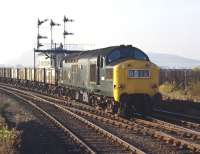
Niddrie West Junction: Class 37 No. 6839 passes Niddrie West signal box and takes the line to Niddrie South with a rake of empty 16t mineral wagons in October 1970. The train is thought to be the 10.15 Mossend - Millerhill Yard. It is definitely not the 11.38 Ravenscraig No. 2 to Carlisle Yard which reported as 8M16. In all probability the loco had been to Carlisle and back the previous day and nobody had changed the reporting number for this trip.
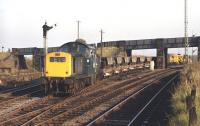
Niddrie West Junction: Scene at Niddrie West Junction on 13 October 1970 with Clayton no 8510 on trip pilot duty E19, coming off the line from Monktonhall Junction with an engineers train.

Niddrie North Junction: Final picture of the day as the light starts to fade on a pleasant October afternoon in 1970. Clayton D8580 passes Niddrie North Junction at 16.39 with trip E13 from Leith South destined for Millerhill yard.
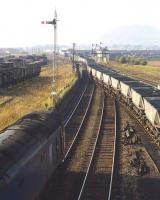
Niddrie West Junction: Class 50 no 414 returning light engine from Millerhill to Polmadie see image [[32389]] is stopped on the approach to Niddrie West Junction on 13 October 1970. The hold-up is caused by class 26s 5303 + 5304 snaking across the formation with MGR empties from Cockenzie PS destined for Fife. Niddrie West signal box stands in the middle distance with the outline of Arthur's Seat just visible through the haze.

Niddrie West Junction: 5303+5304 approaching Niddrie West Junction on 13 October 1970 with MGR coal empties from Cockenzie power station returning to Fife. The train is using the direct route from Monktonhall Junction on the ECML via Wanton Walls. In the right background class 50 no 414 is approaching from Niddrie South Junction on its way back to Polmadie, having deposited its Holborough bound cement empties in Millerhill yard see image [[32389]].

Niddrie North Junction: Clayton 8530 powering round the curve between Niddrie North and West Junctions on the afternoon of 13 October 1970 with the E18 trip taking grain from Leith to the North British distillery at Gorgie.
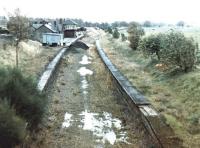
Biggar: The former station at Biggar, South Lanarkshire, looking east towards Broughton on a rainy day in October 1971.

Stranraer Harbour: A Type 2 carries out some shunting operations at Stranraer Harbour in October 1972.

Stranraer Harbour: View towards the buffer stops from alongside Stranraer Harbour station in October 1972 with a train for Glasgow Central at the platform.

Stranraer Harbour: Scene at Stranraer Harbour during a busy period in October 1972 with a ferry docked and a second visible through the mist on the right.

Drayton: The view north through the former Drayton station on 13th October 1979, a few months after demolition of the station building and removal of the road overbridge. All the fabric of the station had been carted away, save for the roof trusses and the ticket hatch and frame which had been left lying at the roadside.

Attlebridge: The closed station at Attlebridge passed into private ownership in the late 1970s and by the date of this photograph, 13th October 1979, had substantially changed in appearance following conversion into a dwelling house see image [[25122]] for comparison. The nearest level crossing gate has long gone, but remnants of the other still persisted within a roadside hedge in 2010.

Wroxham: Saturday shoppers board a Norwich bound Cravens DMU at Wroxham on 13th October 1979.
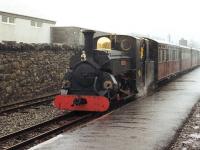
Blaenau Ffestiniog [FR]: Former Penrhyn Quarry Hunslet 2-4-0ST+T Blanche (589/1893) arriving at Blaenau Ffestiniog on 13 October 1982 in pouring rain with a train from Porthmadog.

Glasgow Central: The old order. Glasgow Central - Ayr line DMUs stand at platforms 12 and 13 at Central station on 13 October 1986.
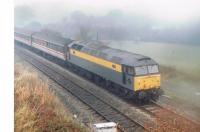
Crigglestone West: Civil Engineer 'Dutch' livered 47975 heads a rake of InterCity liveried coaches on the 'Humber Navigator II' BLS special heading to Woolley Colliery, some 3 miles beyond, on 13th October 1990. The colliery sidings would be accessed a short distance after exiting the Woolley Tunnel, being located just south of the former Haigh Station. The loco was subsequently named 'The Institute of Civil Engineers' the following year.
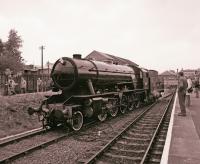
Kidderminster Town: WD 2-10-0 600 'Gordon' running around its SVR train at Kidderminster in October 1996.
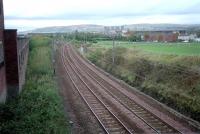
Clydebank East Junction: An October 2001 view west over the site of the former junction for Clydebank East, the 1882 terminus of the Glasgow, Yoker and Clydebank Railway. The continuation of 1897 to Dalmuir is to the right. Clydebank East station closed in 1959 see image [[7524]].
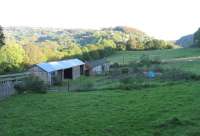
Lydbrook Viaduct: The line of trees behind the farm building is the track of the Severn and Wye climbing from Lydbrook Junction towards the Forest of Dean. The Lydbook valley is to the right of the picture. Under the trees are piles of large dressed stones - the remains of Lydbrook Viaduct. The farm was sold shortly after this picture was taken in 2004 and there is now a large house on the site. The land is still accessible from a public path from the valley road. (Immediately behind the camera lies one of the few visible sections of Offa's Dyke).

Kincardine: New ballast in situ. Rails shortly. Enough space is available for a platform.

Cardross: The leaf train scoots west to Helensburgh

Cardross: The 'Leaf Train' (as I call it) heads west to Helensburgh. This cute little train magically appears every Autumn to clear away fallen leaves.

Duke Street: Original Station entrance re-opened to allow for disabled access!!!
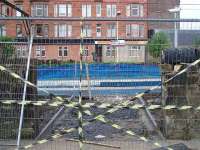
Duke Street: Duke Street, provision of disabled access, October 2006.
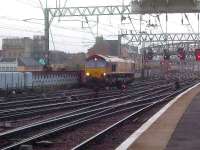
Glasgow Central: 66110 crossing the Clyde Viaduct at Glasgow Central to collect the empty caledonian Sleeper
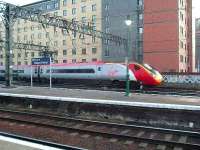
Glasgow Central: A Pendolino departing Glasgow Central for London Euston
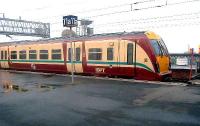
Glasgow Central: 334015 stabled at Platform 11a of Glasgow Central in October 2006. This is the proposed platform for Glasgow Airport under the plans for the rail link. Platform 11a will be extended inside the station and the current shiort stay car park removed.

Mount Florida: Football special comprised of a pair of 334s arrives at Mount Florida on 13 October 2007 following the six and a half minute journey from Glasgow Central.

Thornliebank: A morning train for East Kilbride pulls into Thornliebank under a low autumn sun on 13 October 2007. Unit 156 439.

Carnforth: A touch of fog over North Lancs on 13 October as an ethereal 48151 departs Carnforth past the Virtual Quarry sidings.

Blantyre: 318 250 stands at the northbound platform at Blantyre on 13 October 2007 with a train for Milngavie.

Lenzie: Glasgow - Stirling service stopped at Lenzie on 13 October 2007 formed by 170 475.
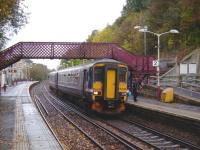
Clarkston: An East Kilbride service formed by 156 492 pulls up amongst the Autumn leaves at Clarkston on 13 October 2007.

Kennishead: Kennishead on 13 October 2007 with 156 514 forming a service to Barrhead.

Kirkhill: 314 214 with a service for Glasgow via Queens Park at Kirkhill on 13 October 2007.
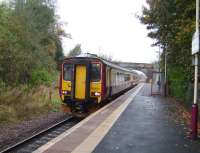
Thorntonhall: A Glasgow Central - East Kilbride train formed by 156 504 seen at Thorntonhall on 13 October 2007.
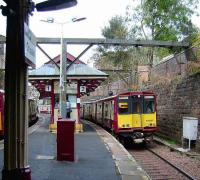
Crosshill: 314 209 arrives at Crosshill on a Newton service on 13 October 2007.
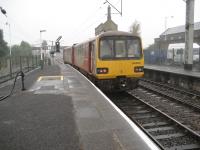
Carnforth: West Yorkshire Metro Train liveried 144004 departs from Carnforth on a foggy 13 October 2007 taking the line to Settle Jct with a service from Morecambe to Leeds. After final withdrawal in 2020 this particular Pacer set moved to the Aln Valley Railway in Northumberland.

Pollokshields East: 314 213, heading for Neilston, calls at Pollokshields East on 13 October 2007.

Hairmyres: 156430 southbound ex-Glasgow Central about to leave Hairmyres on 13 October 2007 on the last leg of its journey to East Kilbride.

Hairmyres: The platform at Hairmyres in October 2007 with 156 430 forming an East Kilbride - Glasgow service.

Belgrave [Victoria]: The 2'6' 'Puffing Billy Railway' runs from Belgrave to Gembrook, 15 miles away. The bulk of the work is done by 6 NA Class Prairie tanks, but they also have G42, a 2-6-0 - 0-6-2 Garratt, built by Beyer Peacock Ltd. in Manchester, in 1926. The latter is shown here exiting the shed yard at Belgrave on 13 October 2008. Interesting to compare the tractive effort of this beast - 27,630 lb, with a Clan Pacific - 27,520 lb.

Belgrave [Victoria]: Class NA (N=narrow) 2-6-2T No. 6A in the shed yard at Belgrave, Victoria, on 13 October 2008. The first two of the class came from Baldwin in the US in 1898 but the others (3A to 17A) were built by Victorian Railways in their Newport (Melbourne) works between 1900 and 1915 for use on their four narrow gauge lines. 6A was built in 1901 and restored in 2002. The locos were moved around the four lines and to Newport for servicing on transporter wagons on the 5'3' gauge.

Belgrave [Victoria]: 2-6-2T 8A takes a train out of Belgrave for Gembrook over the Monbulk Creek trestle bridge on 13 October 2008.

Redcar Central: The original 1846 Middlesbrough and Redcar Railway station at Redcar was replaced by this impressive structure when the line was extended east to Marske and Saltburn in 1861. The building, now the Redcar Station Business Centre, is seen here on 13 October 2009 looking south towards the main entrance from Station Road.

Redcar Central: Hold up at the level crossing over West Dyke Road, Redcar, on 13 October as Freightliner 66951 heads south away from the town with empties on their way back from Tees Dock to the Cleveland Potash complex at Boulby - see [[26149]].

Redcar Central: The 1003 Bishop Auckland - Saltburn leaves Redcar Central on 13 October and runs over West Dyke Road level crossing.
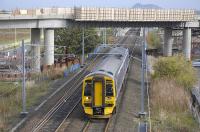
Edinburgh Park: View east towards Edinburgh Park station on 13 October with 158 732 passing below the newly installed tramway bridge and overhead wires.

Princes Street [Tram]: View east along Princes Street on 13 October with concrete 'sleepers' being set out.
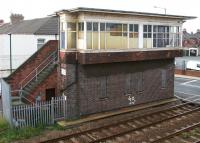
Redcar Central: The signal box at Redcar Central looking south in 2009 with the station on the other side of the level crossing. The UK's first powered sliding telescopic barriers were installed here in 2015, replacing the motorised gates which were in use at the time of the photograph (see [[25917]]).
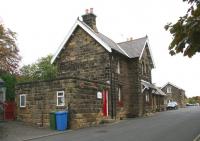
Robin Hood's Bay: The former station at Robin Hood's Bay on the Yorkshire coast, looking north towards Whitby in October 2009.

Brotton: Closed to passengers in 1960, Brotton once handled trains on the Yorkshire coast line betweeen Teesside and Whitby. The old station and its adjoining yard are now used as a tyre and exhaust centre with the station house a private residence. The line has been singled and relaid on a new alignment through the old station and nowadays sees considerable freight traffic in the form of potash from Boulby and steel from Skinningrove.

Marske: The refurbished and re-roofed former goods shed at Marske, between Redcar and Saltburn, seen looking south across the running lines on 13 October 2009. The edge of the North York Moors is visible in the background. [Ref query 21 May 2018]
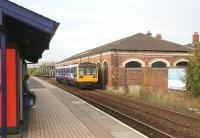
Redcar Central: A Saltburn service pulls away from the staggered eastbound platform 2 at Redcar on 13 October 2009. The train is passing the south wall of the large station building which replaced the original Stockton & Darlington structure in 1861 when the line was extended east. The building is now the Redcar Station Business Centre.

Brotton: The 1875 station at Brotton (closed 1960) on the Cleveland Railway, looking across the High Street in October 2009. The main station building survives here as a tyre and exhaust centre, while the line itself handles considerable freight traffic operating between Teesside and Boulby/Skinningrove.
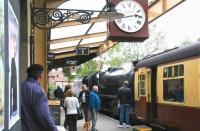
Pickering: ALL CHANGE PLEASE... Black 5 no 45212 stands alongside platform 1 at Pickering on 13 October 2009, having recently arrived with a terminating service from Grosmont.
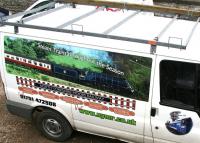
Pickering: One of the NYMR's road transport vehicles in the car park at the north end of Pickering station in October 2009. The colourful side panel features A4 60007 Sir Nigel Gresley.

Robin Hood's Bay: The 1885 station building at Robin Hood's Bay on the Yorkshire coast between Whitby and Scarborough, looking south over the station forecourt on 13 October 2009. Closed to passengers in 1965, the building has now been refurbished and fitted out as holiday accommodation.

Redcar Central: Freightliner 66557 runs over the level crossing at West Dyke Road, Redcar, with a trainload of potash from the Cleveland Potash Co's Boulby Mine on 13 October 2009. The train is heading for the company's bulk terminal at Tees Dock. Note the rubber-tyred wheel and electric motor which operates the crossing gate.

Redcar Central: The Northern 1030 Saltburn - Darlington train arrives at Redcar Central station on 13 October 2009.
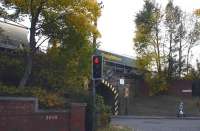
Brotton: The young lady with the shopping pays no heed as one of the frequent freights rumbles over the railway bridge across the High Street in Brotton, North Yorkshire, in October 2009. This route saw a remarkable revival in the 1970s following the discovery of large volumes of potash at nearby Boulby, a discovery which coincided with an increasing world demand for agricultural fertilizer. The large Cleveland Potash complex at Boulby, incorporating Britain's deepest mine, opened in 1973 and potash trains now shuttle regularly between there and the specially constructed bulk terminal at Teesport.

Boulby Mine: View west over part of the 500 acre Cleveland Potash complex near Boulby, north east Yorkshire, in October 2009. The deepest mine in Britain by far at 4,600 feet (and second deepest in Europe), construction began here in 1969 and production of potash, a key ingredient in agricultural fertilizer, commenced in 1973. A secondary product from the Boulby mine is rock salt, which is also produced in high volumes. The site generates large amounts of rail freight traffic, handled via a link to Teesside along the route of the former Whitby, Redcar and Middlesbrough Union Railway, closed in 1958 but reopened from a junction west of Saltburn when production commenced here in 1973. Because of its depth, the site is also home to the UKs Zeplin-III dark matter detector, which is housed in the Boulby Underground Laboratory. Now wash your hands please. See image [[33493]]

Saltburn: The Cliff Lift at Saltburn, the oldest operational water balance lift in the UK. Each car carries a water tank under the floor. The tank of the car at the top station is filled to a level where it outweighs the car at the bottom, at which point it commences the 120 feet descent, at the same time pulling up the bottom car via a steel cable. Water from the tank of the car now at the bottom of the incline is pumped back to the top where the process begins all over again... Operations are controlled by a brake man in the cabin at the top. Saltburn's Cliff Lift, seen here on Tuesday 13 October (only open at weekends at this time of year), has been in operation since 1884.
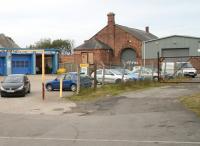
Brotton: The old goods shed at Brotton, Cleveland, seen from the High Street in October 2009. The shed is used as a storage facility by the Tyre and Exhaust Centre off to the left, which itself utilises part of the former station building. See image [[32086]] [Ref query 17 June 2018]
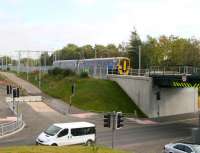
Uphall: The 12.48 Edinburgh Waverley - Bathgate service pulls away from the westbound platform at Uphall on 13 October and is about to cross the recently opened replacement bridge over the widened B8046 road. An entrance has now been formed on the left into the area on the north side of the station where additional car parking will be provided.

Castlemaine [Victoria]: On 13 October 2010 in appalling weather conditions ('The Big Wet') the 10.30 train from Maldon approaches Castlemaine. [Locomotive J541 2-8-0, Vulcan Foundry, Newton-le-Willows, works no 6087, 1953.] The tracks in the foreground are part of the Vicrail main line Melbourne - Bendigo - Echuca.
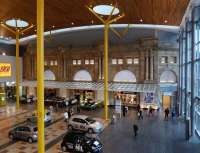
Aberdeen: The impressive remodelled outer concourse at Aberdeen station, seen on 13 October 2010. This is now part of the Union Square development (shopping / cinemas / restaurants / bus station / hotel etc.) See image [[12347]]
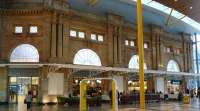
Aberdeen: Another view over part of the remodelled outer concourse at Aberdeen on 13 October 2010.
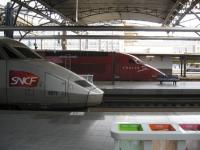
Brussels Midi: TGV and Thalys services at Brussels Midi in October 2010. Note that you are required to seperate your rubbish here when using the platform bins!
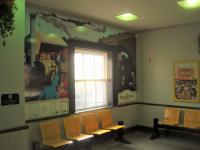
Rainhill: Plenty of murals on the wall of the Liverpool platform waiting room at Rainhill in 2011, leaving you in no doubt that this was a historically significant station. There were further references and plaques outside too. I hope that some or all of this has been retained despite the subsequent electrification of the L&MR.

Rainhill: Passing under the world's first skew arch railway bridge 142032 slows to call at Rainhill on a Lime Street to Stalybridge all stations service in October 2011. The bridge, now listed, is made up of individually shaped stones that were based on a wooden mock up constructed in a nearby field at the time the line was being built. It features in many early prints of the Liverpool and Manchester railway and, at 180 years old, still carries a busy main road. Soon of course it will also have OLE wires underneath it as the Liverpool to Manchester electrification gets under way.
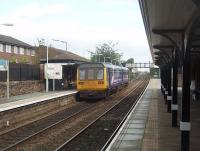
Rainhill: When the Liverpool to Manchester line and others in the North West are electrified it will apparently be cascaded ex-Thameslink 319 EMUs that will provide services see image [[31009]]. Not ideal but undoubtedly an improvement on the even older four wheeled Pacers they will replace. 142032 leaves Rainhill heading east on a Stalybridge service.
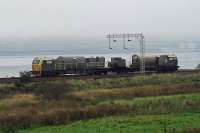
Cardross: 'The Leaf Train' passing Cardross in October 2011 - back for another glorious year of leaf disposal!
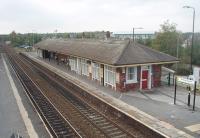
St Helens Junction: St Helens Junction looking towards Liverpool on 13 October 2011. It hasn't been a junction for passengers since the line to St Helens closed in 1965 (goods in 1988) but retains the name to this day, although it serves the community of Sutton.

St Helens Junction: The old bay platform face at St Helens Junction can still be seen but now fronts onto the station car park. This would have been the platform from which connecting trains to St Helens Shaw St departed prior to 1965. Manchester bound trains still use the opposite side of this island. View west towards Liverpool.

Lea Green: Lea Green's original station closed in 1955 but reopened in 2000 at a new location a few hundred yards to the east serving a new development. 150218 calls on its way to Liverpool Lime Street along the old Liverpool and Manchester main line. The original Lea Green station was sited by the bridge that can just be seen in the distance.

Kilmarnock: DBS 66207 carefully negotiates the points at Kilmarnock on 13 October 2011 with the 4S92 Drax to Greenburn empty hoppers.

Rainhill: The Rainhill Locomotive Trials of 1829 are so embedded in railway history that it is surprising to learn that Rainhill station was known as Kendricks Cross until 1843. It makes the most of its heritage now though and there are numerous display boards and plaques marking its significance. The station building itself, with its distinctive awning, dates from 1870 and is still staffed. A Manchester bound Pacer calls on a Northern stopping service from Liverpool.

Lea Green: When Lea Green was reopened on a new site in 2000, 45 years after the original station closed, this road level booking office was built, completely separate from the two platforms in the cutting [[36074]].

Prescot: The semaphores at Prescot, which include this curious little bracket starter, will not survive the forthcoming electrification. 156472 heads towards St. Helens on a stopping service from Lime St to Wigan. The modern flats occupy old railway land.
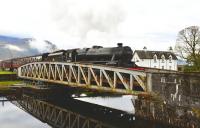
Banavie Swing Bridge: Black 5 no 44871 eases slowly across the swing bridge at Banavie with The Jacobite on 13 October 2011.

Prescot: Drawing up alongside the original, and still staffed, station building at Prescot on 13 October is 156472 on a stopping service from Liverpool to Wigan. This view looks towards Huyton and will change soon as the electrification of the line proceeds.

Perth: A view from Platform 4 at Perth of the carriage sidings in October 2012.

Gorebridge: The cleared site at Gorebridge on 13 October 2012, with the 1847 station building receiving attention. View south from Station Road bridge over the planned car park.
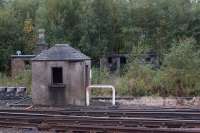
Perth: Buildings and grounded van body to the west of the station at Perth in October 2012.
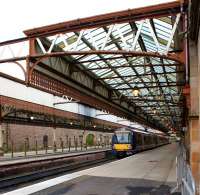
Perth: A Perth - Edinburgh service waits in Platform 5 at Perth on 13 October 2012.
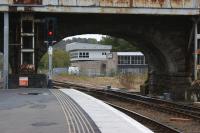
Perth: Perth SB viewed from the south end of platform 5, under St Leonards Bridge, on 13 October 2012.

Keith Town: 46512 and five DMU coaches preparing to form the 15.00 train to Dufftown at Keith Town on Saturday 13th October.

Campbeltown: A view east from the top of the 1:35 bank that runs through the deep tree lined cutting down to the Campbeltown quayside. The notice board alongside the footpath gives information about the community woodland but unfortunately makes no mention that this is the track of the old light railway line.
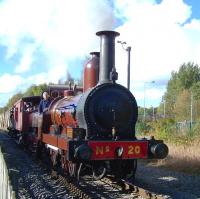
NRM Shildon: Veteran ex-Furness Railway 0-4-0 No 20 of 1863 at work on 13 October hauling brake van trips within the grounds of the NRM at Shildon see image [[22343]].
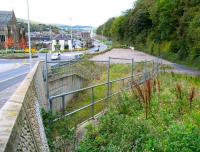
Galashiels: Standing on the bridge over the Borders Railway route at Station Brae, Galashiels, on 13 October 2012. View is north towards the station site with demolition and clearance work now completed here. See image [[39258]]

NRM Shildon: Preserved diesel shunter D4157 (TOPS 08927) at NRM Shildon in October 2012. See image [[42036]]
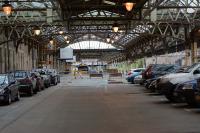
Perth: A Class 170 DMU waits at platform 5 with a service from Perth to Edinburgh on 13 October 2012. The outline of where the two north facing bays had been can be seen immediately in front of the camera.
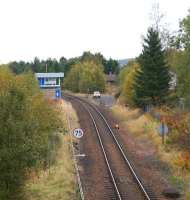
Stanley Junction: Looking north east towards Stanley Junction on 13 October 2012 with the line curving left towards Murthly. The former double track main line to Kinnaber Junction would have been where the signaller's car is parked in the middle of the picture. A house has been built on the trackbed beyond the car. See image [[7377]]
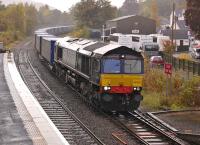
Pitlochry: DRS 66424 about to run through Pitlochry station on 13 October with the 4D47 Inverness - Mossend Intermodal service.
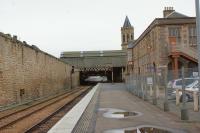
Perth: Looking south along a deserted platform 4 at Perth on a dull 13 October 2012.
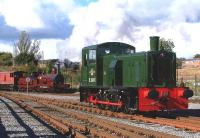
NRM Shildon: Scene in the yard at NRM Shildon on 13 October 2012 featuring D2090, with ex-Furness Railway 0-4-0 no 20 passing with a train of brake vans in the background.
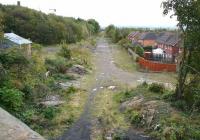
Newtongrange: The Waverley trackbed running through the site of the proposed Newtongrange station on 13 October 2012. View is south from the A7 road bridge looking towards Gorebridge.
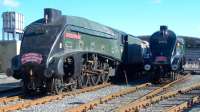
NRM Shildon: Renewing an old acquaintance. Gresley A4 Pacifics 60010 Dominion of Canada and 60008 Dwight D Eisenhower together in the sidings at NRM Shildon on 13 October 2012.
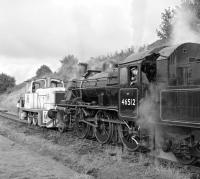
Strathmill Distillery Siding: Having arrived at Keith Town as the 16:15 from Dufftown, Ivatt class 2 46512 and its train of dmus are propelled back along the running line to Strathmill Distillery Siding by EE 0-6-0 DM Spirit o' Fife. Here the 2-6-0 will be released into the siding, allowing the coaches to be taken back to the station by the diesel shunter.
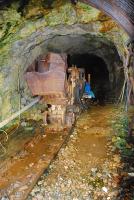
Cononish Gold Mine: A view looking into the Cononish gold mine, south of Tyndrum, through the security grill. A short section of partly dismantled track runs to sheds and the spoil tip. The lines describe a triangle.
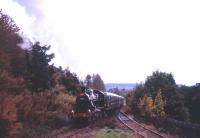
Strathmill Distillery Siding: Part of the elaborate shunting process required to operate the Keith & Dufftown Railway's 2012 steam weekend - 46512 propels empty stock of five DMU coaches past Strathmill Distillery siding see image [[39133]] in fast disappearing light on the late afternoon of Saturday 13th October.

Perth: A DBS Class 66 takes the Dundee route at Perth station on 13 October 2012 with a rake of tank wagons.
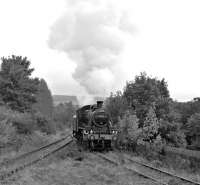
Strathmill Distillery Siding: With its train of dmus standing on the running line behind it, Ivatt class 2 46512 runs into Strathmill Distillery Siding. This will allow EE 0-6-0 DM Spirit o' Fife to couple onto the ecs and haul it back into Keith Town station. The 2-6-0 would then work the final train of the day to Dufftown. See image [[43799]]
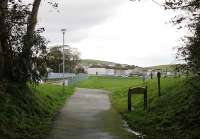
Campbeltown: The site of the Campbeltown and Machrihanish carriage and loco sheds, now an open space, was just at the top of the steep bank from the quayside. This is the modern day view looking west from the end of the deep cutting with its trackbed footpath. The houses in the distance are built over the old line. See image [[33469]] for a map showing the cutting and sheds in 1921.
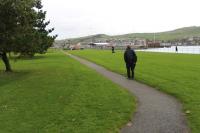
Campbeltown: At the foot of the bank in Campbeltown the C&MLR trains emerged from the cutting onto the foreshore and turned left towards the harbour. See image [[37847]]. This tarmac footpath follows the line of the narrow gauge track across the green but, as with the other surviving bits of the railway, no mention is made of its origins and why the path follows the route that it does. An information board in this area would be very useful for the uninitiated.
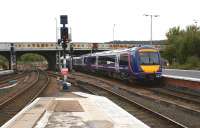
Perth: 170423 heads south from Perth on 13 October 2012 with a service to Edinburgh from Inverness.
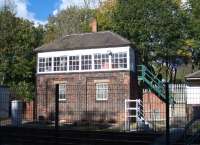
Shildon: The signal box at Shildon in October 2012. The box stands to the east of Shildon station.
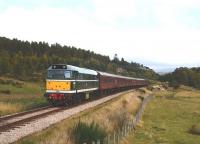
Broomhill: Replacing the Ivatt Class 2 which had failed due to a broken spring, class 31 No.5862 evokes memories of the steam/diesel transition era as it leaves Broomhill on 13 October with the 13.30 service for Aviemore.
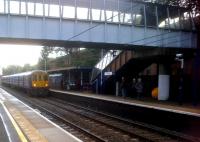
Radlett: An up EMU coasting to a halt approaching the unusual canted glass footbridge at Radlett on 13 October 2013. The weather was distinctly dreich.
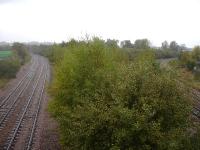
Rotherham Masborough: View south from Rotherham Masboro in October 2014, with the Midland Railway old main line to Chesterfield, bypassing Sheffield, on the left and the current main line to the right. Note the severe curve prior to the latter reaching the junction with the Holmes Chord line from Rotherham Central. See image [[49308 for the view north from the same bridge.]]
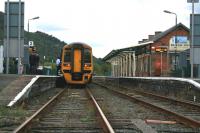
Porthmadog: The 1652 service to Pwllheli about to depart Porthmadog on 13th October 2014. The former station building has been restored after being damaged in the storms in February 2014. See image [[47963]]
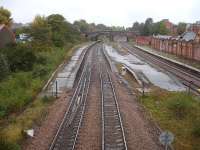
Rotherham Masborough: Looking north over the almost intact Rotherham Masborough station in October 2014 (closed October 1988), showing the passenger lines used by cross country services in the foreground and the goods lines to Chesterfield, avoiding Sheffield, over to the right. A goods loop line still exists, albeit covered in vegetation, on the far left. See image [[41035]]
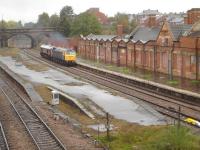
Rotherham Masborough: Looking north over the former Rotherham Masborough station on 13 October 2014 as 47815 hauls 59003 Yeoman Highlander south to Eastleigh Works from Immingham docks. The ex-Foster Yeoman class 59 had been repatriated from Germany following purchase by GBRf.
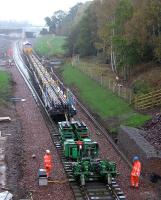
King's Gate Junction: The first main line train to reach the solum of the Waverley Route since the last track-lifting train passed through in late 1972. Just after 14.30 on a wet Monday 13th October 2014, GBRf 66736 propels the tracklaying train through Kingsgate Points where the new Borders Railway alignment via Shawfair joins the original route from Millerhill through the trees to the right.
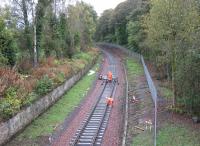
Sheriffhall [2nd]: The advance guard of the Borders Railway tracklaying train drops rails into place just south of Kingsgate Points in the early afternoon of Monday 13th October. See image [[38706]]
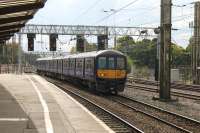
Preston: The October 2015 timetable changes have seen most of the Liverpool - Blackpool services cut back to Preston but they are now handled by 4-car EMUs rather than Class 156 Sprinters. 319383 rolls in to Platform 2 at Preston on a service that started at Liverpool South Parkway and ran via Lime St and St Helens.
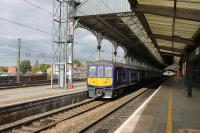
Preston: The new order at Preston station in 2015. Northern Electric 319383 draws in to Platform 2 for a very quick turnaround prior to returning to Lime St via St. Helens Central. The four car EMUs have replaced two car 156 Sprinters on these services, which in turn are doubling the size of trains on other Northern routes.
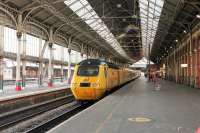
Preston: Crew change for the Network Rail Flying Banana at an otherwise very quiet Preston station. The HST Measurement Train, powered by 43062 and 43013, was on its scheduled run from Derby to Ayr on 13th October 2015.
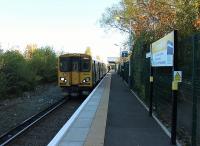
Ormskirk: Ormskirk Now and Then. EMU 508136 waits at Ormskirk prior to departing for Liverpool Central. See image [[19549]] of the same location in 1972, since when the footbridge and down line have been removed, the bay platform has been filled in to form a footpath and there has been a general increase in the amount of vegetation. However, the end on meeting with Preston DMUs continues to this day and a Class 153 Sprinter stands behind the EMU.

Moy: With the jets blasting, 67018 Keith Heller works the rail head treatment train back to Inverness from Moy on a sunny October afternoon.
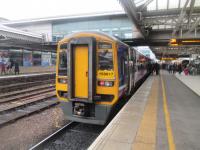
Sheffield: 158817, on a service to Leeds via Barnsley, waiting to depart from Sheffield on 13th October 2016.
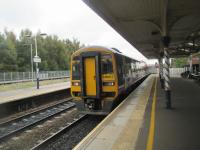
Chesterfield: 158817, working to Leeds via Barnsley, seen arriving at Chesterfield station on 13th October 2016.
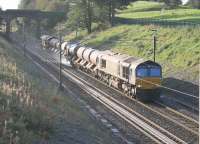
Galgate: With the extra rails inside the Up line track giving a resemblance of a trough this RHTT train passing Galgate appears to be picking up water rather than spraying it. A grubby DRS 66423 is in the lead with 66429 bringing up the rear on a diagram from Kingmoor that started at 1715hrs the previous evening and covered the WCML, Barrow, Windermere and a return trip along the S&C to Armathwaite before finally going back via Shap to arrive at 1200hrs.
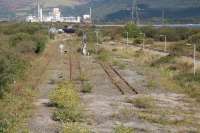
Margam Sorting Sidings South Box: Looking North towards Margam East Jcn. The line on the left is the only line that is connected to the yard but is heavily overgrown.
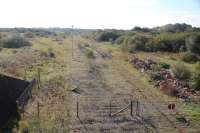
Margam Abbey Works East Junction: Looking south over Margam Yard. The running shed was off to the left now completely demolished as has the wagon repair. The pile of rubble on the right is the remains of the South Sorting Sidings Signal Box.
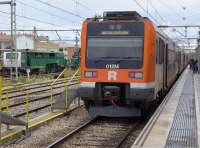
Sant Vincenc: Local EMU on arrival from Barcelona. Note the low-visibility tamper in the sidings!

Sant Vincenc: Southbound Talgo speeds through. The restricted clearance on the platform can be disconcerting!
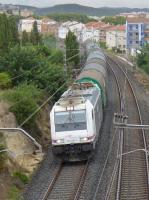
Saint Vincenc de Calders: TRAXX loco 253 090-5 heads away from the junction at Sant Vincenc de Calders with a southbound freight on 13 October.
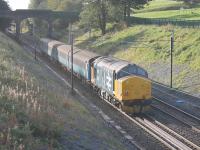
Galgate: The upgraded cutting at Galgate is green again. 37403 Isle of Mull propels the 0515 Carlisle to Preston service south on 13th October 2016. See image [[55136]] taken the previous April when the work had just been completed.
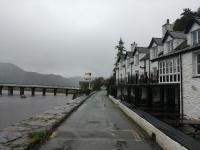
Penmaenpool: Friday the 13th, lunchtime, a miserable wet and cold day and unfortunately no time to stop at the hotel for a warm up. Penmaenpool is a hamlet on the south side of estuary of the River Mawddach in Wales, near Dolgellau. The former trackbed through the site is now in use as a footpath, the Llwybr Mawddach or Mawddach Trail. This view looks towards the old station site with the toll bridge on the left.
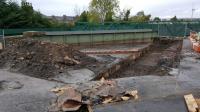
Dunblane: The exposed beams on Perth Road bridge, just south of Dunblane station, on Friday 13th October 2017. The bridge was to be removed early Saturday morning with new beams being installed over the weekend.

Barmouth Viaduct: North end of Barmouth Bridge, looks like a sleeper or two needs replacing.
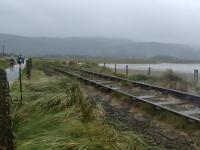
Barmouth: A very wet and windy morning, this is just after south end of Barmouth bridge, hard to believe this track is in use.
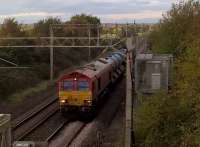
Hanslope Junction: Train 384E, topped and tailed by DB 66's, is an RHTT from Bescot TMD to Euston. It was seven minutes early as it sprayed its way towards Hanslope Junction after passing through Northampton station and over the M1.

Lancaster [1st]: The original L&PJ station in Lancaster was only used by passengers from 1840 to 1849 but most of its site continued in use as the city's railway goods depot until the 1960s. This goods platform has survived the redevelopment of railway land as the hospital car park. The old passenger station is at the end of the grey building to the right of the trees See image [[18309]]. [Ref query 13 October 2017]
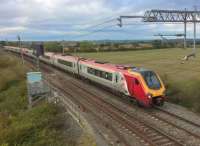
Hanslope Junction: Enter stage left: a double Voyager heads for London - probably from Holyhead - on the Northampton avoiding line.
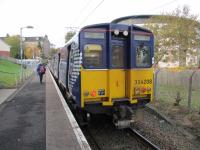
Paisley Canal: Still going strong, one of the old timers 314208 waits at the Terminus to return to Glasgow Central
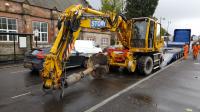
Dunblane: A roadrailer (with an impressive auger attachment) being delivered to Dunblane station on 13th October 2017 in connection with the project to remove and replace the Perth Road railway bridge.
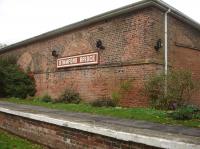
Stamford Bridge: The old goods shed at Stamford Bridge Station, seen here in October 2018, is located alongside the NW end of the former Beverley bound platform. The running in board is in a slightly different position to views from when the station was open. The shed is currently used as a sports facility.
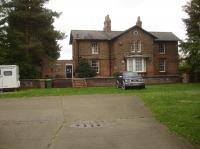
Fangfoss: View in a westerly direction to the York bound platform and station building at the former Fangfoss Station on 13th October 2018. The platforms were staggered either side of the level crossing, sited across the divide between Station Road and Ling Lane, out of view to the right. The Beverley bound platform was sited by the level crossing keepers cottage. See image [[66263]] The station building and goods yard now form part of a large caravan site.
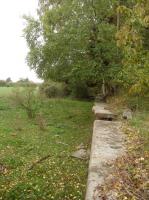
Fangfoss: Looking in a north westerly direction along the Beverley bound platform of the former Fangfoss Station in East Yorkshire. The platforms were staggered either side of the former level crossing to rear of view, with the crossing keepers house to right of view. See image [[66297]] 13th October 2018.
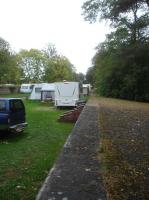
Fangfoss: Looking in a south easterly direction along the York bound platform of the former Fangfoss Station that is now part of a caravan site occupying the station and goods yard site. The Beverley bound platform is on the other side of the level crossing, to rear of view, by the former crossing keepers house. See image [[66263]] 13th October 2018.
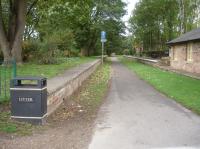
Stamford Bridge: Looking from the former level crossing across the platforms and trackbed at Stamford Bridge station on the former York to Beverley line. The Beverley bound platform has been lowered to accommodate the single storey building, now known as The Old Station Club. The former goods shed can be seen through the trees to right in the background. [Ref query 24 October 2018]
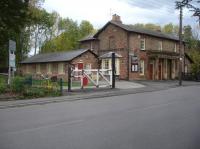
Stamford Bridge: Looking north across the site of the level crossing to the former Stamford Bridge station main building serving the former York to Beverley line. The two platforms are still extant to left of the crossing, as is the goods shed beyond. The station and goods yard site now forms part of a public park. A moderate distance NW of the station lies the lengthy brick arched viaduct crossing the River Derwent. 13th October 2018.
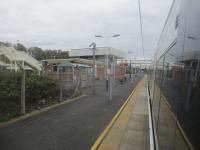
Pitsea: Pitsea, Essex, looking east, seen from 357035 calling with a C2C service from Fenchurch Street to Southend Central via Ockendon, on 13th October 2019. The original station here opened in 1855 and was re-sited in 1888 when it became a junction with the completion of the LTSR cut-off line from Barking via Upminster which joined the original route here at Pitsea. There are four platforms, those on the later (direct) line are on the far left of the buildings.
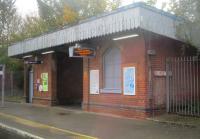
Ockendon: The up (loop) platform buildings at Ockendon station, Essex, seen from 357035 calling at the down platform (on which the main building is situated) with a C2C service to Southend Central, on 13th October 2019. This single track line between Upminster and Grays was opened by the London, Tilbury & Southend Railway on 1st July 1892 and, despite being electrified in 1962, had only a shuttle service between the two ends of the line for very many years. The opening of a further station at Chafford Hundred, between Ockendon and Grays, in 1993 boosted passenger numbers on the line and it now has a regular all day service of trains between London Fenchurch Street and Southend Central.
See query 2179
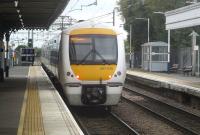
Benfleet: 357035, with a C2C service from Fenchurch Street to Southend Central via Ockendon, departing from Benfleet on 13th October 2019. Benfleet opened in 1855, with the extension of the LTSR from Tilbury to Leigh-on-Sea, and is the station for Canvey Island.
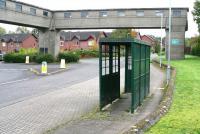
Lady Victoria Colliery: The Lady Victoria elevated walkway, looking east from the National Mining Museum on a Sunday morning in October 2019 see image [[70784]]. The final span linking the walkway with the pithead baths was demolished long ago, with the houses of Colliery View now occupying the site. Similarly, off to the right, modern housing on Lingerwood Walk and Lingerwood Road, stands on the site of the eponymous pit. A legacy of the old arrangement is the cast iron bus shelter still standing alongside the layby. Today the layby is used as a parking area by staff at the adjacent mining museum offices.
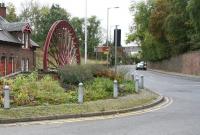
Newtongrange [Village]: View south from the village towards the National Mining Museum in October 2019. The type and location of company housing allocated to Lothian Coal Company employees was determined by rank within the pit. These slightly larger dwellings on the edge of the village would have been for overmen or lower management. Note the road sign for the museum and the elevated walkway alongside the main entrance. On the far right is the the remains of the western abutment of the bridge that brought coal from Easthouses and Lingerwood over the road into Lady Victoria.

West Horndon: The London, Tilbury & Southend Railway reached Leigh in 1855 and Southend in 1856, both of which were re-christened 'on Sea' by the LTSR Directors to encourage day trippers. (The extension from Southend to Shoeburyness did not open until 1884.) The route to Southend via Tilbury was extremely circuitous so a more direct cut-off line from Barking in the west, rejoining the original line at Pitsea was sanctioned and this opened between Barking via Upminster to East Horndon on 1st May 1886 and was completed to its junction at Pitsea on 1st June 1888. East Horndon station was renamed West Horndon by British Railways Eastern Region on 1st May 1949. This view shows the rather splendid station building on the eastbound platform, seen from 357020 with a C2C service to London Liverpool Street, NOT Fenchurch Street, on Sunday, 13th October 2019.

Benfleet: 357009 and 357026, with a C2C service to Shoeburyness, arriving at Benfleet, Essex, the station for Canvey Island, on 13th October 2019.
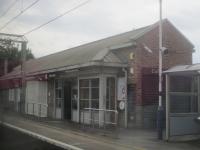
Tilbury Town: The up platform at Tilbury Town, seen from a departing C2C service from Fenchurch Street to Southend Central via Ockendon, on 13th October 2019. The London, Tilbury & Southend Railway opened from a junction with the Eastern Counties Railway at Forest Gate to Tilbury Fort in 1854 but this station did not open until 15th June 1885 as Tilbury Dock. It was renamed Tilbury Town by the LMSR (who inherited the line, well outside its geographical territory, at the 1923 Grouping), on 3rd August 1934.
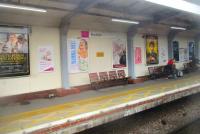
Basildon: The eastbound platform at Basildon station, Essex, seen from 357020 from Shoeburyness to London Liverpool Street (diverted from Fenchurch Street) departing on 13th October 2019. When the New Town of Basildon was being planned and built in the late 50s/early 60s, and despite the fact that the ex-LTSR main line passed right by its main shopping centre, in 1961 the General Manager of BR Eastern Region made the astonishing statement that it was 'not worthwhile' to build a station and that the townsfolk could easily use either Laindon or Pitsea stations and continue to Basildon by bus, which is exactly what they had to do. Naturally, this met with protests which fell on deaf ears for several years but eventually Basildon station did materialise and was opened on 25th November 1974, the station that the town should have had some 15 years earlier.
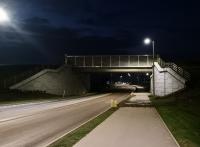
Daventry International Rail Freight Terminal: A Bridged Addition: this sturdy and stylish rail-over-road bridge so far connects two stretches of embankment. The bridge over the A5 has not yet been built -see image [[52516]] - and nor have the sidings parallel to the M1 which will be to the right of this view, after a 90 degree East to North curve. This splendidly isolated bridge seems to be wide enough for 3 tracks; view looks North. Very dark for 7pm!
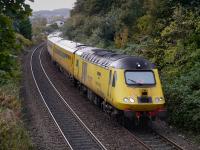
Sinclairtown [2nd]: The Network Rail New Measurement Train climbs away from Sinclairtown with a Crewe - Edinburgh - Montrose - Slateford run, on 13 October 2020.

Brock Aqueduct 46 [LC]: The Brock Aqueduct (Bridge 46) is another Rennie structure, dating from 1797. It carries the Lancaster Canal 22' above the River Brock on a single span and the very tall parapets are a notable feature.
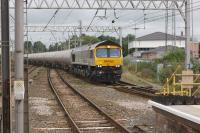
Carlisle: Modern Railfreight A new freight flow. GBRF 66793 crosses the southern approach to Carlisle station with aviation fuel from Grain Oil Terminal to Prestwick BP Oil terminal on 13 October 2021. The train had run in the path normally used by the Irvine China Clay tanks from Wembley via the WCML to Farington Jct, then east to join the S&C at Hellifield. How frequent this service will be is not yet known. #COP26
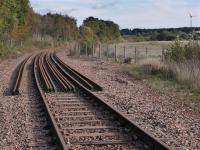
Earlseat Loading Pad: New rails for the Levenmouth branch, deposited at Earlseat in the early hours of 10 October 2021. The coal loading pad siding branched off to the right (see image [[40284]]).

Lathom Junction [LLC]: A number of old working boats on the Leeds and Liverpool have been converted into pleasure craft or floating homes. 'Mersey', moored near Lathom Junction in October 2021, is a typical example of one of these wide-beam craft. I can just remember the last of them in commercial service in the late 1960s around East Lancashire, painted in BWB blue and yellow. They sit a bit higher in the water now than when loaded with power station coal or other bulk loads.

Glenrothes with Thornton: 170450 arrives at platform 1 at Glenrothes with the 14.07 from Edinburgh on 13th October 2021. In the background is Earlseat Wind Farm. Curiously, the unit ran empty to Redford Junction (for Thornton Yard), stopped for a few minutes, then returned to GwT becoming the 15.20 to Tweedbank. This in spite of there being no conflicting movements.
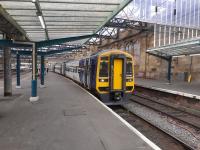
Carlisle: Northerns 158848 waits in platform 5 at Carlisle in October 2021 with an S&C service to Leeds.
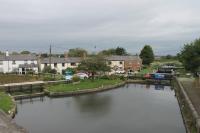
Lathom Junction [LLC]: What is now known as Lathom Junction, just to the east of Burscough, is the point where the Rufford Branch connects with the main section of the Leeds and Liverpool Canal. This October 2021 view looks north from the towpath bridge as the branch drops away from the main line through several locks. The Rufford Branch was a quiet backwater for many years but with the creation of the Ribble Link to the Lancaster Canal is now part of a through route for canal boats, albeit one that involves a challenging trip from Tarleton Lock along the tidal River Douglas, Ribble Estuary and Savick Brook.
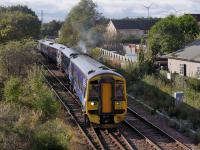
Glenrothes with Thornton: The 13.49 from Edinburgh to Glenrothes with Thornton, formed by 158725/707/739, crosses over at Thornton West Junction to call at platform 1 where it will continue as the 14.53 to Edinburgh via Kirkcaldy on 13th October 2021.

West Bryans Siding: ScotRail 170394 heads north towards Edinburgh shortly after leaving Newtongrange in bright autumn sunshine on the morning of 13 October 2022. The train is rounding the curve onto Newbattle Viaduct and is about to pass the compound standing on the site of West Bryans exchange sidings. The cramped facilities were used by the Newbattle Collieries Railways prior to World War 1, before becoming redundant on the opening of the Lothian Coal Companys spacious Lady Victoria complex half a mile to the south.
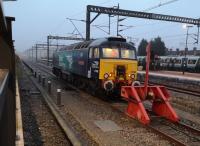
Rugby: The lights are on, and someone is home - 57308 'Jamie Ferguson' didn't seem to be going anywhere, but its engine was running for some 15 minutes - charging up the batteries, perhaps. To misquote JF Kennedy, eternal vigilance will cost you some diesel fuel.
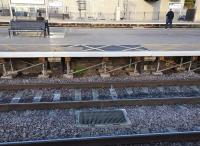
Milton Keynes Central: If platform 4 at Milton Keynes ever appears in court, its financial affairs will be beyond dispute - it has visible means of support. Peter Parker's memorable quote about the crumbling edge of quality also springs to mind.

Haymarket: The cafe at Haymarket remains unlet on Platform 4, but these new vending machines have appeared upstairs. Incidentally the 1101 wasn't a full cancellation on 13th October 2022. Owing to late running it just wasn't stopping.
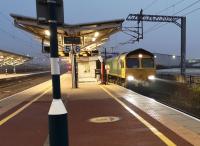
Rugby: 66536 pierces the dawn as it heads for the Northampton Loop with 4L52 from Garston to London Gateway on 13th October 2022. Another Freightliner with the same origin and destination followed ten minutes later, but I was busy elsewhere.
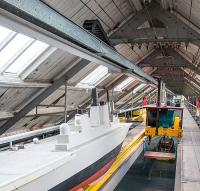
Denny Tank Museum: A view down the length of the testing tank at the Denny Tank Museum, Dumbarton (owned by the Scottish Martime Museum). The Leven Ship Yard Experimental Tank was setup by William Denny & Brothers in 1883 and has a memorial plaque to the pioneer William Froude, 'The Greatest of Experimenters and Investigators in Hydrodynamics', who died in 1879.
Events
Events from the chronology which occured on this day. This generally lists events before 1995, the creation of the website.
| Year | Companies | Description |
|---|---|---|
| 1853 | Edinburgh Station and Branches (Caledonian Railway) | From 1st_>Slateford Junction 1st to a bay platform by the Edinburgh and Glasgow Railway's Haymarket station opened. Trains could run from the bay to Carstairs or Falkirk. The line is opened with a running of the Royal Train to Haymarket. The connection at Haymarket was taken out later. |
| 1856 | Ayr and Maybole Railway | Opened to freight. |
| 1898 | Glasgow Corporation Tramways | First electric tram runs from Springburn to Mitchell Street. |
| 1962 | Forth and Clyde Canal | Glasgow University Railway Society charter Ashton for a trip along the canal |
News
These are old news items which which occured on this day. This generally lists events after 1995, the creation of the website.
| Year | Companies | Description |
|---|---|---|
| 2003 | Feasibility studies on Container Hubs at Hunterson and Orkney | Transport Minister, Nicol Stephen, indicated that hubs for transferring cargoes from larger to smaller vessels is being considered. Hubs could be developed at Hunterston and Orkney. The Hunterston area is served by rail. |
| 2006 | Abseilers will jump to it [Scotsman] | A CHARITY abseil from the Forth Rail bridge is being staged this weekend. |
| 2006 | GNER trains clocking up punctuality records [Scotsman] | RAIL giant GNER said today it was breaking punctuality records with nine out of ten trains travelling between Edinburgh and London now arriving on time. |
| 2006 | MP wants city rail plan axed [Scotsman] | A SENIOR Labour MP has called for the planned Waverley railway line to the Borders to be axed. |
| 2006 | Trains delayed as coach gets stuck under bridge [Scotsman] | HUNDREDS of train passengers were delayed when a coach got stuck underneath a rail bridge in the Capital. |
| 2006 | SNP accused of U-turn as rail link is slammed by Salmond [Scotsman] | SCOTTISH Nationalists were today accused of a U-turn on Edinburgh^s airport rail link. |
| 2010 | British Rail to be wound up [Railnews] | THE government has announced that British Rail is to be finally wound up -- seventeen years after the first Act of Parliament was passed which launched railway privatisation |
| 2011 | Three die on Scotland’s railways [Scotsman] | THREE people died on Scotland’s railway lines yesterday evening. British Transport Police (BTP) started two separate investigations following the deaths, all of which were in the central belt. One person was hit by the 6.30pm Glasgow to Edinburgh train at Linlithgow station. A short time later a young man and woman were hit by the 7.43pm Ayr to Glasgow train at Milliken Park station in Renfrewshire. Police said none of the deaths are suspicious. |
| 2013 | Stirling-Alloa-Kincardine railway line needs rebuild [Scotland on Sunday] | ONE of Scotland’s newest railway lines will have to be largely rebuilt at a cost of up to £17 million – just five years after it was opened. The Stirling-Alloa-Kincardine line is expected to be closed for periods over the next five years while “pretty extensive engineering work” is carried out, according to sources. Network Rail has confirmed it is planning substantial repairs to the line, which was built by other firms. The work – costing a fifth of the original construction price – is likely to involve excavation down to the foundations in places. |
| 2013 | Abellio has no concerns over Borders Railway [Herald] | A leading candidate to take over the ScotRail franchise has brushed off concerns over the commercial viability of the Borders Railway project, saying that it will present a ^suite of ideas^ about how to incorporate the expected loss-making new service within a profitable network. Abellio, a subsidiary of Netherlands Rail, claims to have established an early lead in what will be a closely-fought battle to win the 10-year franchise to run 85% of the Scottish rail network. Its bid is based on its previous experience of running a ^social railway^ which boosts passenger numbers. |
| 2013 | Great Western^s 132-year-old royal carriage restored [BBC News] | A Victorian railway carriage once used by royalty has been restored in Cornwall. The saloon car was built for VIPs by the Great Western Railway in Swindon in 1881. Although the carriage was not part of the royal train, it was used privately by the then Prince of Wales, who later became King Edward VII. [From Richard Buckby] |
| 2014 | Britain to sell its 40% stake in Eurostar [International Railway Journal] | THE British government has announced plans to sell its 40% stake in cross-Channel high-speed operator Eurostar to help reduce the national debt. The British Treasury has set a deadline of October 31 for companies to prequalify to purchase the shares and it hopes to select investors during the first quarter of 2015. UBS is advising on the sale. [From Richard Buckby] |
| 2014 | New Metrolink line to Wythenshawe and Manchester Airport to open on November 3 – a year ahead of schedule [Manchester Evening News | Trams on the new Metrolink line to Wythenshawe and Manchester Airport will run with passengers on board from early next month - more than a year ahead of schedule. Metrolink bosses have confirmed an opening date of November 3 for passengers wanting to use the new 14.5km route. [From Richard Buckby] |
| 2015 | Glasgow Crossrail: Will the ‘missing link’ be built? [Scotsman] | IT’S long been a source of frustration for passengers who face walking across town in order to change trains. The lack of a connecting link between Glasgow Central and Queen Street stations means a five minute dash along Buchanan Street for those looking for a train south after arriving from the east and vice versa. |
| 2015 | Network Rail crisis to come under spotlight [Railnews] | THE continuing budget crisis at Network Rail is to be probed by a House of Commons committee. The Public Accounts Committee said it will hear evidence from several key officials on 21 October as part of its inquiry into Network Rail^s investment programme. Those to be questioned are the Department for Transport permanent secretary Philip Rutnam, Network Rail chief executive Mark Carne and ORR chief executive Richard Price. [From Richard Buckby] |
| 2016 | ScotRail Alliance ^committed^ to Far North Line [BBC News] | The operator of Scotland^s railway network has reiterated its commitment to the Far North Line in the Highlands. ScotRail Alliance, which involves Abellio ScotRail and Network Rail, has been criticised for the quality of services on the line. A railways expert and MSPs have concerns about the long-term future of the line that links Inverness to stations in Sutherland and Caithness. But ScotRail Alliance said it was investing in the line. |
| 2016 | ScotRail to spend £100,000 on ^secret shoppers^ [Herald] | SCOTRAIL is to spend £100,000 on undercover ‘mystery shoppers’ to ride its trains amid growing criticism of the services being provided by the Dutch operator of the franchise. A London-based firm, BDRC Continental, has been awarded the lucrative contract to carry out the audits and will see up to 220 journeys taken by people tasked with discretely monitoring services every month. The secret shoppers, who are paid “a small incentive†in addition to train fares, will visit stations and interact with staff before going on their journeys, even riding on replacement buses when necessary. They will then report back on their experience in a bid to help bosses understand its service from a customer’s perspective. |
| 2016 | Rail delays: New plans to compensate passengers [BBC News] | Rail passengers will be able to claim compensation for delays of more than 15 minutes under new government plans. They can currently only make claims when services are delayed by at least 30 minutes. The Department for Transport said its new scheme will initially launch on Govia Thameslink Railway services in the next few months before being expanded on other networks. Passenger and rail industry groups said they supported the plans. The changes would also see compensation of 100% of the single fare ticket value for delays of between 60 and 119 minutes. |
| 2016 | Contenders named for next Welsh franchise [Rail News] | THE Welsh Government has chosen four possible operators of the next Welsh franchise, which starts in 2018 when Arriva^s 15-year contract comes to an end. The aim is to create a ^not for profit^ organisation, which the government said will be modelled on Transport for London. The Government has selected Abellio Rail Cymru, Arriva Rail Wales/Rheilffyrdd Arriva Cymru Limited, KeolisAmey and MTR Corporation (Cymru) Ltd, all of whom will now move on to the next stage of the competition. A public consultation will also start in the New Year. The successful bidder, to be known as an Operator and Development Partner, will run trains in Wales, assist with the evolution of the South and North Wales Metros and manage the transition to electric trains in several parts of the Principality. [From Richard Buckby] |
| 2017 | Edinburgh to London in 45 minutes - Branson reveals Hyperloop plans [Scotsman] | Sir Richard Branson has invested in a Hyperloop firm which he claims will transport passengers between London and Scotland in 45 minutes. The billionaires Virgin Group has formed a partnership with Los Angeles-based Hyperloop One, which is developing a method of propelling passengers and freight in pods through low pressure tubes at high speed. Virgin described it as the worlds most revolutionary train service. |
| 2018 | First new ScotRail train back on track after fault fixed [BBC News] | The first of several new trains taken out of service over a technical fault is back in operation after the problem was resolved, ScotRail has announced. It was one of three Hitachi class 385 electric trains taken off commuter routes after a brake control system issue was detected earlier this month. The seven-carriage train began operating again between Edinburgh and Glasgow via Falkirk High on Saturday. The remaining two trains are expected to return to service next week. The fault, which ^led to a small loss of signalling across the brake network cables^ was identified on 4 October. |
| 2019 | Early completion for Queen Street platform works [Network Rail] | Network Rail has successfully completed the lengthening of platforms 4 and 5 at Glasgow Queen Street station. |
| 2019 | Passengers locked out and deprived of coffee in fresh Caledonian Sleeper woes [Scotsman] | Long-suffering passengers on Caledonian Sleepers new fleet have encountered yet more problems “ being locked out of their rooms and coffee not being available in the morning. |
